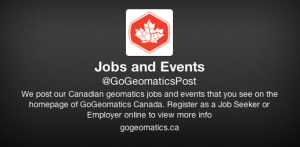How to Start Your Career in GIS
You are reaching the point of your life where you are finishing up your last year of college or university and your next step is finding a Geographic Information Systems (GIS) entry-level job. You are probably asking yourself questions and wondering:
Where do I start?
What are the first steps to take?
What tools can I find and use to help me find my first job?
In this article, I will go through some of the steps that I took that enable me to obtain an entry level position. As well as I will review the tips I wish someone had told me while I was starting my search for my first job in GIS and geomatics. 
A Matter of Perspective
Before you begin your search, you must get into the right mindset and understand that in looking for a new job can be very time consuming and can take months before you actually start to see results. In addition, a graduate’s first role within GIS might not be the ideal job he or she wants because it may not provide benefits or the desired pay rate, however all of this is part of the learning curve.
It is more than just submitting hundreds of job applications online
Though using an online job board might be the easiest and most convenient way to apply for jobs, you are up against an overwhelming amount of applicants and it can be very competitive. In general, when applying online be aware of the job posting you are applying for because it might have received hundreds of applicants beside yours. Make sure you customize your resume in order to make it stand out from the rest. An important tip is to save all the applications you submit with a copy of the job posting in a place you will remember, just in case the company comes back to you a couple of months later.
Submitting your resume on job boards can be very repetitious with very little reward, so try sending emails or calling companies that you are interested in working for. In this case, it can be discouraging with very few companies responding to your emails, but if the company sees potential in you they will get back to you when there is a vacancy, whether it is in a few weeks or a couple of months.
Alternatively, look into internships and volunteer opportunities, as these positions could lead to a full-time job and more connections for you within the industry. GISCorps coordinates volunteer opportunities whether it is short or long-term in a variety of oversea projects. I was successful in obtaining an internship through the Environmental Youth Corps (EYC) Internship Program, which is funded by the Environment and Climate Change Canada’s Science Horizons Program. This program can provide up to 50% of an intern salary (up to $15,000) to an employer that works within the fields of science, technology, mathematics, or engineering (STEM) and provides the intern with a new full-time environmental job.
Network, Network, Network!
Networking is a crucial part while you are on your search to finding your entry-level job. Let everyone know you are searching for a job in your field, you never know your family member or friend might have a connection that could help land a job.
Another way to start connecting with professionals in the industry is to set up a coffee date with a GIS professional, where you can get advice from them and learn more about the industry. In addition, try attending local conferences and printing a handful of your resumes or create business cards for yourself that you can distribute to the companies or professionals attending the event. Nevertheless, GoGeomatics has monthly social gatherings you can attend in order for you to get to know professionals who are working within the field or others that are in the same position as you. 
Networking not only involves connecting with people face-to-face these days, but connecting on social media platforms, such as LinkedIn. This means creating a LinkedIn account and keeping it up to date because recruiters use LinkedIn to find candidates to fill vacant roles.
Gather your maps and create a portfolio!
One of the first things I did after graduating from my GIS program, was composing and selecting maps that exemplified my skill set and polishing them up in order to make them more professional. I then printed them in colour and had them bound. Now that I had a career portfolio I was able to present my capabilities or skill set of composing maps while I was at an interview.
Creating a portfolio can give you the upper hand of landing the job and impressing the interviewer. Make sure you remember the steps and procedures for creating your maps in order to thoroughly explain them to a future interviewer.
Most importantly, the best advice I received from someone while I was searching for a job is to be patient, as the right job for you will come at the right time. Also never take the first opportunity you get if it will not help you progress to your career goal. As you embark on your journey to find your GIS job, remember to be optimistic, have an open mind, be patient, be receptive to the challenges and the perfect opportunity will come your way.
Please feel free to comment below if you have any additional tips for a new and young professionals who are searching for GIS career jobs.







There are some very good points in this article. One point that could have been made is that the whole process of obtaining a position (or starting your career) can go a whole lot easier if you start long before you are about to graduate. Indeed, I would recommend that you should start planning for your career when you are BEGINNING your college or university program. I have given a paper to several gatherings of students on things that students should do if they want to be employed. It is copyrighted by the IEEE so I cannot post the paper. However, I can made it available to students who contact me by e-mail with the subject line “GoGeomatics Jobs.” bryersonatkimgeomaticsdotcom. I will not respond to students seeking employment – I no longer have employees, nor will I read any attachments – I don’t like viruses!
I often hear the advice about creating a portfolio. I wish I had started off like Priscilla and always saved examples of my best work in presentable form. However it still would be tough for me as I’m usually working with proprietory client data, and my work is focused on data processing and analysis not creating a cartographic product.
Hi Priscilla, great tips! I’m also an alumna from Fanshawe and am trying to get my GIS career started. What type of maps best demonstrated a wide range of GIS skills? Looking to build my portfolio.